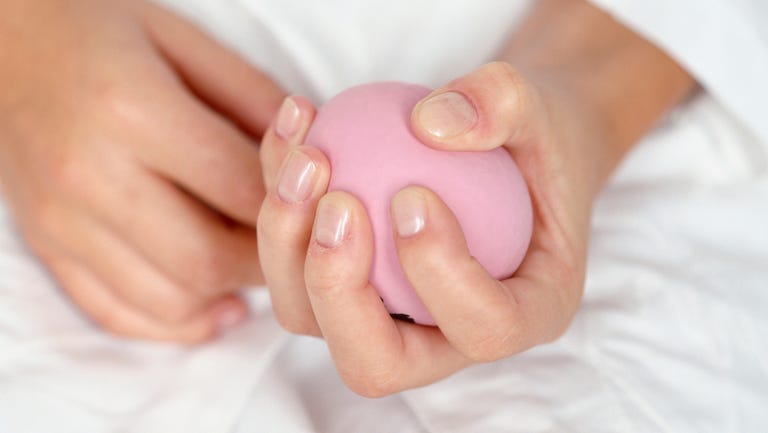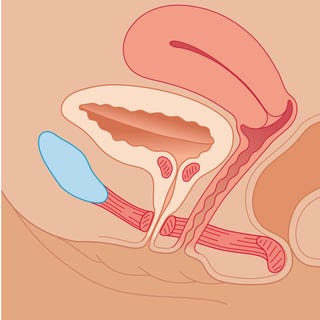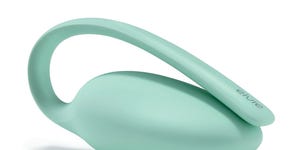
In a full-body workout, you tone your arms and shoulders, plank your way to a tighter core, and show your lower body all the love with lunges. But there’s one very important set of muscles you might be missing: your vag.
Kegels, the toning and strengthening exercise for your pelvic-floor muscles, are having a bit of a moment, even though they’re an old-school exercise. The simple squeezes are so important for below-the-belt health—and your sex life.
We asked the experts to weigh in on everything you need to know about how to do kegels—and why you definitely don’t want to skip them.
What are kegels?
“First and foremost, kegels are a way to strengthen the pelvic-floor muscles, which are sort of like a hammock that surrounds the pelvis,” says Leah Millheiser, M.D., director of the Female Sexual Medicine Program at Stanford University School of Medicine. Kegels work just like any other exercise—by contracting a muscle, you make it stronger.
In the case of kegels, that means squeezing your pelvic-floor muscles—these are the same muscles you squeeze when you’re trying to stop yourself from peeing, and the area of the body your Pilates instructor is always reminding you to engage in class—to keep them toned and tight.
What are the benefits of kegels?
We usually hear about kegels as a below-the-belt rehab regimen—especially in the context of strengthening your vagina after giving birth. “When women have a little bit of looseness of the pelvic floor after childbirth, kegels can help build up those muscles and facilitate the process of healing,” Millheiser says.
Working your pelvic-floor muscles also helps prevent symptoms of urinary incontinence, she explains. In other words, if you ever pee a little when you laugh, cough, or sneeze, kegels may help. “It’s not a cure-all for incontinence, but it’s certainly a starting place,” Millheiser says.
But kegels also have another major (and more fun benefit)…
Can kegels make your orgasms more intense?
Hell yeah, they can. “When you think about what an orgasm is, it’s a rhythmic contraction of the pelvic floor,” Millheiser explains. “Strengthening those muscles can potentially help those orgasms become more intense.”
Their orgasm-strengthening power makes kegels a recommended exercise for women going through menopause, who might feel like their orgasms have become a little…womp womp over time, Millheiser says. But you don’t have to be in orgasm rescue-mode to reap the benefits—if your orgasms already feel powerful, regularly doing kegels might make them even more out-of-this-world.
How do you do kegels the right way?
1. Locate the muscle.
Unlike your biceps, your pelvic-floor muscles can be a little tricky to find. Next time you go to the bathroom, try to stop yourself from peeing mid-stream. Feel that squeeze? Those are your pelvic-floor muscles. (Side note: Even though this is a helpful one-time way to identify your pelvic-floor muscles, you should never do your kegels when you’re peeing. Regularly stopping your stream like that can cause bladder issues, Millheiser says.)
2. Make sure you’re actually squeezing. “You can test you if you are doing kegels correctly by placing a finger in the vagina and squeezing the muscles—you should feel a lifting and contraction around your finger,” Saya Segal, M.D., a urogynecologist at Weill Cornell Medical Collage who specializes in pelvic-floor weakness. If you’re still not sure if you’re doing it correctly, you can ask your gyno to check during your next exam, she adds.
3. Remember to hold, not pulse. Once you’ve got the hang of it, hold your squeeze for between three and 10 seconds and release for three seconds. Imagine you’re trying to keep a marble from falling out of your vagina—think pulling in, not pushing out, says Adeeti Gupta, M.D., a gynecologist and founder of Walk In Gyn Care in New York.
4. Make it a part of your daily routine. Do ten reps for one set, working your way up to three sets a day. “This is something people have to do on a regular basis—it’s not just something you do for two weeks and then you’re good,” says Millheiser. Just like meditation or yoga, it should ideally be a consistent daily practice. “You have to do it for about six months daily to see a real difference,” Millheiser says.
The good news is, you can do kegels just about anywhere—if you’re doing them the right way, kegels are super discreet. “No one should be able tell you are doing these exercises and the buttocks or thigh muscles should not contract,” Segal says.
5. Try an app. If you want to up your kegel game, there are a handful of vaginal-fitness trackers designed to help you track your pelvic floor gains. Some even come with devices you insert down there to give you more info to work off of. “These trackers can potentially help guide you if you have difficulty identifying the muscles or want feedback,” Millheiser says. “What those programs are most helpful for is to show you how you’re improving—some apps will tell you how strong your squeeze is and you can track that over time.”
6. But be wary of what you put up there. Make sure it’s made of silicone, which won’t irritate your vag, says Gupta. “And make sure you clean them every day after use with mild soap and water,” she says.
Does everyone need to do kegels?
Even if you don’t have issues like incontinence, kegels are a generally recommended part of your feminine-healthcare routine.
But there are some exceptions. “If you’re having any symptoms that are related to having a tight pelvic floor, I would advise skipping kegels,” Millheiser says. If you have a condition like vagininismus, tightening these muscles is the last thing you want to do.
If you’re having significant pelvic-floor issues—either pain from a condition that causes tightness, or weakness that’s not getting better after six months of doing regular kegels—Millheiser recommends seeing a pelvic-floor physical therapist for more insight into what might help.
Source: Read Full Article



